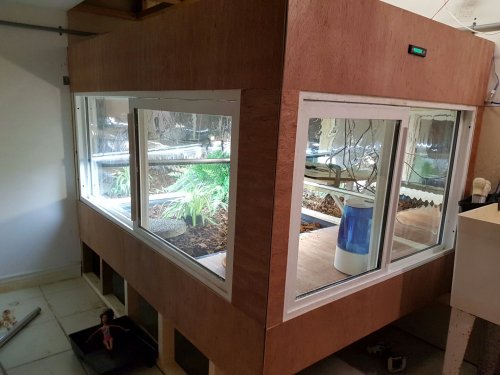Hello I have a question for the experienced members on this forum.
I'm a newbie to this forum and chams but not a stranger to reptiles. I currently keeping hermanns tortoises and burmese star tortoises.
The two species are in separate enclosures as their requirements are quite different.
My burmese stars are in a 6 long x 4 wide x 3.5 high. The substrate is 6 inches of bark mulch that has a lively variety of superworms, adult beetles, centipedes, pull bugs as my eco balancing system. I have 3 burmese torts wondering around this enclosure and obviously only on the ground. There are boston ferns, hibiscus and few other Tropical plants in the enclosure. One reptisun 10.0 and another 6500k hot5 for lights. Sprinklers turn on for 1 min 3x per day keeping humidity around 80-90%. Heat is supplied by oil filled radiant heater at 89F during the day and 80F at nights.
So I think you can guess where I'm going with this in the purpose of this thread. Is this compatible with chameleons? I'm leaning towards Panthers but open to other suggestions based on the temps. I was getting an excess number of beetles from the superworms which got me thinking of a compatible pet that could help control the beetles.
I would have to modify the setup slightly by enclosing the heater with mesh and covering the t5 bulbs and fans with mesh as well.
For those unfamiliar with burmese star tortoises, they are peaceful and not aggressive at all.
Thoughts? Suggestions? Chameleons species recommendations bases on my temp? Is that environment too warm for chameleons?
Here's a picture of my enclosure when I first built it. It has grown in quite a bit with more plants inside now.
I'm a newbie to this forum and chams but not a stranger to reptiles. I currently keeping hermanns tortoises and burmese star tortoises.
The two species are in separate enclosures as their requirements are quite different.
My burmese stars are in a 6 long x 4 wide x 3.5 high. The substrate is 6 inches of bark mulch that has a lively variety of superworms, adult beetles, centipedes, pull bugs as my eco balancing system. I have 3 burmese torts wondering around this enclosure and obviously only on the ground. There are boston ferns, hibiscus and few other Tropical plants in the enclosure. One reptisun 10.0 and another 6500k hot5 for lights. Sprinklers turn on for 1 min 3x per day keeping humidity around 80-90%. Heat is supplied by oil filled radiant heater at 89F during the day and 80F at nights.
So I think you can guess where I'm going with this in the purpose of this thread. Is this compatible with chameleons? I'm leaning towards Panthers but open to other suggestions based on the temps. I was getting an excess number of beetles from the superworms which got me thinking of a compatible pet that could help control the beetles.
I would have to modify the setup slightly by enclosing the heater with mesh and covering the t5 bulbs and fans with mesh as well.
For those unfamiliar with burmese star tortoises, they are peaceful and not aggressive at all.
Thoughts? Suggestions? Chameleons species recommendations bases on my temp? Is that environment too warm for chameleons?
Here's a picture of my enclosure when I first built it. It has grown in quite a bit with more plants inside now.








